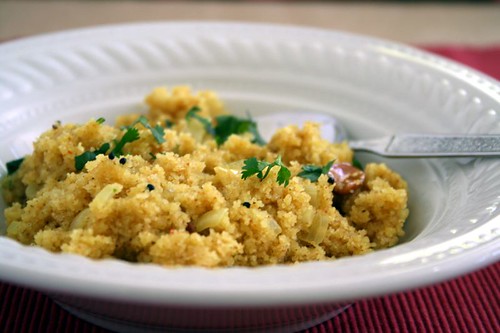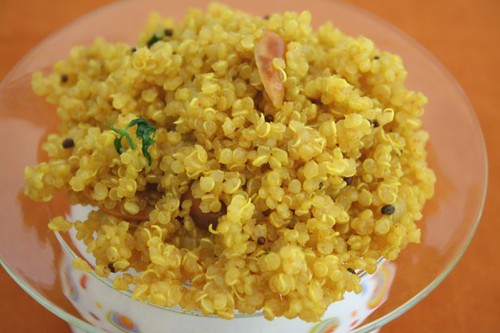
Before I go ahead, let me introduce Maushi M, my mother's older sister, famous for her 'aagraha'. Yup, the same force-feeding-with-love that I mentioned once before. People were known to make all kinds of excuses when they visited her - "I just had lunch", "I am on my way to dinner", and so on, but nothing worked. Her mission seemed incomplete until people left her home groaning under the amount of food she brought out.
I had many reasons to visit or stay over at her house, because her daughters were my friends and their house was minutes away from ours. So there were numerous occasions when I fell under her 'aagraha', and I have tried all ways to finagle my way out of it, with no success. She is a great cook of everyday food, but one of the things I have eaten umpteen times at her house is sanza, and she makes the best one I have ever eaten. Never lumpy or sticky, and always delicious. It was something she would make in minutes, practically in the same time that tea was prepared on the next stove, or a 'limbu sarbat' (lemonade) was stirred up if it was a hot afternoon.
After I left home and started cooking, I asked my mother to get me her recipe, with no secrets withheld. One of those secrets was that she always kept a jar of roasted rawa ready, so that she could conjure up the sanza anytime. I still have the original copy of the recipe, even though I do not need it anymore because I know it so well by now, and have always meant to convert it to standard measurements and translate it, but never got around to doing that. Here it is.
Ingredients
1 cup of coarse rawa (semolina or farina)
1 small yellow onion
2-3 Tablespoons oil
3-4 Tablespoons of peanuts (or as much as you like)
1/4 teaspoon mustard seeds
pinch of hing (asafoetida)
1/4 teaspoon turmeric (or a little more if the turmeric is pale)
8-10 curry leaves
1-1/2 teaspoons salt (or to taste)
1 teaspoon chili powder
1 teaspoon sugar
some chopped cilantro, grated coconut, and wedges of lemon or lime for serving
Method
Pour the rawa into a deep skillet, and roast on medium high heat until it gets evenly golden brown in color and keep it aside to cool. This roughly takes 5-10 minutes.
Dice the onion. Heat the oil in a kadhai or wok. When it gets hot, fry the peanuts in it, and remove them with a slotted spoon to a small bowl.
Let the temperature of the oil come down a little, and then add the mustard seeds (they will pop right away since the oil is hot), hing, turmeric, curry leaves and onion. Saute it for a few minutes until the onion softens, and add 2 cups of water.
When the water comes to a boil, add the salt and chili powder. Start adding in the roasted rawa in a steady stream with one hand, while stirring it together with the other. Reduce the heat, add sugar and fried peanuts and stir through completely until the rawa has absorbed all the water. [At this point, the original recipe says to take a teaspoon of oil and drizzle it around the edge of the pan, but I don't do that.] Serve it right away, with a little bit of cilantro and coconut on top and a wedge of lemon or lime on the side.
Is it like Upma?
In terms of technique, it is very similar to its famous sibling 'upma', and is usually eaten for breakfast, or at tea time in Maharashtra, but I'll keep the spotlight on the lesser known one in this post. The seasoning is different, and naturally, so is the taste. It is also not as moist as upma, in fact in a good sanza the grains of rawa can be well separated, though they don't have to be. I have also rarely encountered any vegetables other than an occasional potato in a sanza, unlike upma which ranges from plain to additions of vegetables and cashews.
Adaptation with Quinoa
If you have read my posts until now, you know I cannot resist twists on ingredients and techniques. I had always wanted to try Quinoa for a long time, for its high nutrition value and protein content, but only when I read about how to cook Quinoa on the-cooker's blog, I knew that I could try giving it the sanza treatment. It worked out very well. 'The Cooker', thank you for those pictures and information!

I used the above sanza recipe as it is, but there was no need to roast the grains beforehand. After the water started boiling and spices were added, I stirred in the quinoa, turned down the heat and cooked everything for roughly 10-15 minutes, and added the sugar and peanuts at the end. By then, the grains absorbed all the water, and the germ ring was visible too!
At this point, it is actually hard to decide which one I like better. The original will always remain a favorite, no doubt, but the quinoa version will not be left behind either, especially when a good protein boost is needed.



























21 comments:
sanza ia new to me. tip for roasting rava:
line a baking sheet with parchment or a silicone mat. put the semolina on it, bake at 350F for 8-10 minutes. you can make a large quantity this way. let it cool, lift the edges of the parchment or silicone mat and pour the rava into a jar.
I regularly use bulgar to make upma from this.Today I learn another new name for it.and new additions to the recipe.I love reading food blogs for this very reason.Love the quinoa version too,BTW.I have been meaning to try it since a long time.Perhapsw now I will shrug off my laziness and go to the local health food store for a pack of quinoa.
Sanza is new to me. From your photo, you seem to have achieved the right consistency to distinguish it from upma. Nice pix
The dish looks totally satisfying but I've never heard of sanza before. Thanks for the info.
Never heard of Sanza! But now I know!:))
Quinoa is one thing I want to try and can't get here so far.Looks great there.
that pic of yellow sanza is mouthwatering :)
the ring around the quinoa grain looks so beautiful, makes it look so exotic!
I love the color here, it would make such a bright plate.
I loved this post. A new dish for me. The colors are great.
Never thought of keeping roasted rava handy. Good tip. Sanza is gr8. Its gonna be my dinner someday this week :)
Thanks to ALL of you for stopping by with your kind comments.
bee, I will try out your excellent tip for roasting rawa.
vini, sra, cynthia, asha, gini: sanza is a very homestyle dish in maharashtra, and I think few people outside of that would know of it, which is one of the reasons I wrote about it, so that people can try out something new.
asha, look for quinoa in a 'Whole Foods' type of store if you have one in your area.
richa, thanks, and yay, someone who knows about this dish too.
kelly, glad you liked the color. I assume this would be something quite different to you too?
gini, sra, welcome to my blog! I saw your blogs real quick and they are pretty.
suganya, 'aunties' have some really neat tips, don't they? Let me know if you try it out.
Quiona i need to find this. looks appetizing.
Roopa, would you find Quinoa in Singapore? You could try the regular rawa one otherwise.
Quinoa sanza....what a great idea.
Great photos, as always.
Quinoa has found a permanent place in our home. If you haven't try quinoa kheer! You'll love it, I'm sure of it.
Thanks Cooker. Much of the credit goes to you of course, for inspiring me in the first place. Quinoa Kheer, hmmm - do you have a recipe? Approximate one will do.
Don't have a share-worthy approx recipe. I was totally winging it when I made it.
Will make it again (and post it)after I return from Pune.
Arre wah - are you on vacation in Pune? Hope you are having fun. Look forward to the recipe.
Wow, the picture makes me want to reach out. Beautifully delicious!
I just bought some quinoa finally (and some israeli couscous! both were in the bulk buy section of Andronico's and I missed them all these months), and am going to try the saanza. Remembered both your recipes as I saw them.
Yaay! Glad you found em. Quinoa is quite a protein booster, so you might want to explore it into other things like 'quinoa upma' or khichadi. Seems quite adaptable to me.
Any idea where i can find quiona in Pune...ive tried many stores..
Shivani, knowledgeable friends have recommended that you can try looking at Dorabjees or Hypercity.
Post a Comment